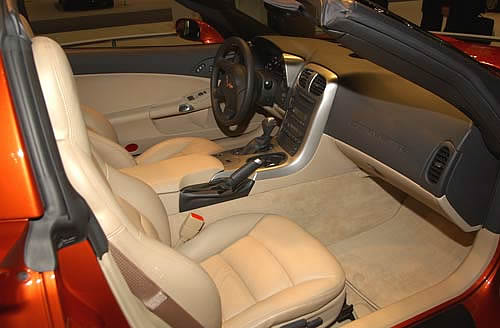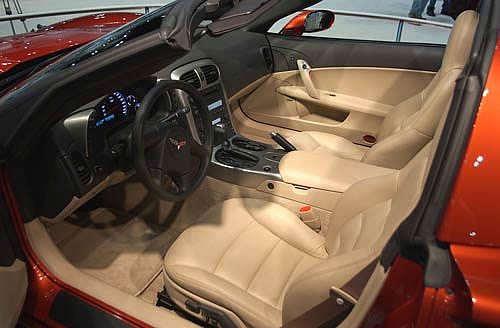C6, Naked and Exposed: Corvette Action Center's First Look at the 2005 Corvette - Page 3 of 6
 |
 |
C6, Naked and Exposed: Corvette Action Center's First Look at the 2005 Corvette - Page 3 of 6
by Hib Halverson
©2004 Corvette Action Center
No use without permission
Inside the Oh-Five - Continued from Page 2...
As I sat in the C6, I can't say I had a strong feeling of "precision" Chevy said I'd experience, but the interior does seem more spacious as well as looking brighter, modern and less-cluttered. The flush-fit radio and climate controls, the surrounding trim plates and the instrument panel-to-door closure are part of what gave me that feeling. The color of the interior we sat in was called "Cashmere". Also, available are Ebony, Steel Gray and Red.
While the new interior materials, indeed, seem more "rich", conspicuous was a steering wheel that looked like it was picked out of some other model's parts bin. If that's the case, it's a curious choice in light of the stated goals of the C6 interior design. Chevrolet did something similar back in the '70s: fitting Vettes with steering wheels out of lesser models. It wasn't a good idea then and may not be now. Another thing I don't like? The grab bar which was in front of passengers in '97-'04s is missing.
The C6 targa's lift-off roof system has been substantially revised. The panel itself is larger which enhances the "open-air" feeling one gets with the roof off and reduces wind buffeting. The panel weighs less making it easier to remove and load in the cargo area. A revised roof panel storage position makes for more cargo space under the panel. The roof snaps into its storage and three levers are pulled to remove it. Targas come standard with a colored roof. Optional is a clear roof along with a "dual-roof" package which gets you both.
The '05 Vette has enhancements for your bodily comfort and safety. A six-way power driver seat and a manual adjusting passenger seat, both with manual recliners, are standard. The seats' construction is similar to that of C5, ie: an aluminum base with a two-layer, composite seat frame. Hopefully, the C6 recliner mechanism improves on C5's which was sometimes prone to malfunction once it had aged only a modest period.
If you pop for the uplevel "sport seats", which gets you power-adjustable back angle, lumbar and side bolsters, you also get side-impact air bags for driver and passenger. We only sat in the C6 for a few minutes and the sports seats felt like they had better thigh support, however, good automotive seating really shows its stuff when you're driving the car, not just sitting in one parked on a stage. On paper, C6's seating improves, but we'll pass on the final judgment until GM lets us drive one. Finally, filling some dire need-perhaps in the opinion of a marketing weenie who spent last winter in the U.P.-heated seats finally come to Corvette as an option. How did we survive without them?
The C5's analog instruments, tachometer, speedometer, oil pressure, coolant temperature, voltage and fuel level, were continued in theme but improved in execution. Most of the idiot lights moved from the faces of the tach and speedo to the area between them. The diameters of those two gauges were increased by .2-in. The gauge graphics were redesigned to improve legibility and the lighting system is now white LEDs with the gauges backlit at all times, offering high contrast, even in bright sunlight. C5s gauge lighting was very good and C6's is a measure better. The "Driver Information Center" (DIC) uses organic light emitting diodes (OLED) where are self-luminous and eliminate the need for backlights. The C6 DIC displays two lines of data where as C5 only had one.
The Head-Up Display (HUD) returns as an option, however, it's been upgraded with a dot-matrix display along with other new features and enhanced functions. The HUD projects data onto the inside of the windshield in front of the driver using an LCD. The display is aimed so it appears to "float" on the road ahead, just below the driver's line of sight, allowing the driver to focus on driving while monitoring speed and other information.
New for '05 are two HUD modes: "Street" and "Track". In Street mode, the driver selects configurations which feature a digital speedometer and turn signals, and then adds other information such as audio system data, automatic transmission gear selection, and high-beam indicator. In Track mode, there is a large analog tachometer, engine condition gauges and a real-time lateral acceleration display which reads maximum "g-force" attained in a turn. Our favorite use for the C5 HUD was reading corner exit speeds. Once we drive C6, it will be interesting to see if the "max. lat." display is as useful.
There is a plethora of convenience, entertainment and information electronics available for '05. Of course, you get remote, keyless entry. Once again, it can operate as a passive system. Move in close proximity of a door with the key-fob in your pocket and the doors unlock. Touch the membrane switch and the door opens. Once you're inside, whoa...no key switch! All locking and security is accomplished electronically. To start the car, you just press a button on the dash. We hope reliability of this system is better than was C5's sometimes troublesome steering column lock.
Standard is an AM-FM Stereo with CD player, MP3 playback capability and seven speakers. The mid-level system adds Bose speakers and a 6-disc, in-dash, CD changer. The uplevel system adds a navigation computer but deletes the CD changer because there's not enough space behind the dash for both. While gadget freaks will probably order navigation in droves, if it were my C6; I'll use a map if I can load six CDs for the trip. The nav system consists of a GPS receiver, a 6.5-in. (416x240 pixels) TFT, EGA, color, touch-screen display and a CD/DVD drive. The screen folds down for access to the CD/DVD drive. The nav. system can display turn-by-turn route guidance on the HUD. All map data for the U.S. and Canada is stored on one disc. The nav system's voice-recognition software supports multiple languages. A 100-channel, "XM" satellite radio receiver and GM's On-Star are available with any of these systems. Optional on C6 is the popular ³homelink² transmitter used to operate a garage door opener and two other user-selectable functions. C6 continues using hidden AM and FM radio antennas. With C5, reception from this hidden antenna on the AM-band was marginal at best. Chevrolet claims C6 has new antenna technology that improves reception. We hope so but we'll wait until we test a production unit before we'll buy that.
Most of the time, my use of a Corvette is for long road trips so I need lots of interior storage. In this respect, C6 improves over C5 with increased cockpit storage capacity. There is now room in the console box for a cell phone, sunglasses and six CD cases. The lid is easier to open, has more durable hinges and improves accessibility to the lock regardless of the driver seat position. Both doors have storage pockets. The glove box grows from 0.14 to 0.16 cubic feet and its door hinges are damped for slower, more graceful opening. The rear cargo area's storage pocket doors are integrated into the floor for a cleaner, more organized look. The doors are hinged, too, so they stay open for easy access but closed when you're driving hard.
While storage space in the cockpit increases, cargo space behind the seats actually decreases by 2.2 cu/ft. Chevrolet tells us there's still space for two golf bags, but we suspect, once you have those two bags in there, there isn't as much space left. The loss of the 2.2 cu/ft. is probably from the shortening of the car. Chevrolet claims the shortening was achieved "...with virtually no loss of usable space." but that claim doesn't agree with the specifications it supplied for the car. The explanation of this situation may come when Chevrolet tells us how it defines "usable space".
Our look at C6's interior would not be complete without coverage of cup holders. Clearly, some high-level executives at GM drive fast while sucking down Slurpees because Chevrolet's PR machine advised media that C6 offers "...two cupholders designed to handle the car's high lateral acceleration capability. Adequate stability for lateral and fore/aft acceleration was a top priority to keep two travel cups or 20-oz. bottles in place during performance-driving maneuvers."
But wait, there's more! In addition to improved cup retention, the holders have a tambour (sectioned like a roll-top desk cover) door which keeps them hidden when not in use. The door enhances the console's appearance and allows the holder to serve as covered storage when not carrying drinks.
 |
 |

